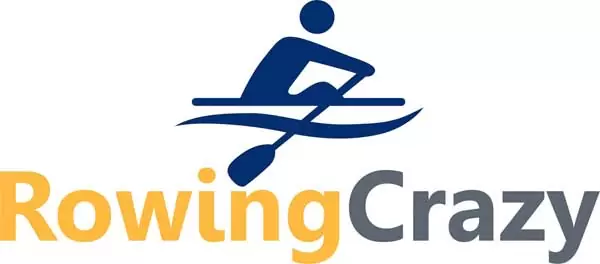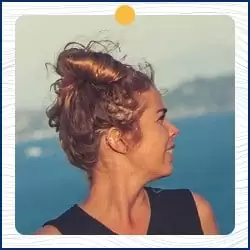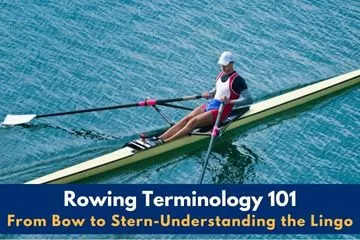
When it comes to sports, no matter if it’s football or basketball, soccer or tennis, there is a certain lingo that comes with it.
Hi, I’m Petra, and if you’re new to rowing, you might find yourself wondering if you’re in another country! What language are these people speaking?
Sweep? Scull? Coxswain? What do these words mean, and how can you figure it out without looking like a complete newbie?
I created this glossary of rowing terms for everyone who didn’t spend their youth at regattas (a racing event for rowing) or learning how to row.
I’ve tried my best to include every term I could think of, even ones that might be considered common knowledge.
Bookmark this page so you can refer to it quickly when you hear a word you aren’t familiar with. Before long, you’ll be talking like you grew up rowing, and no one will be the wiser!
- Related Topic: Funny Rowing Jokes!
Rowing Terminology: The Boat
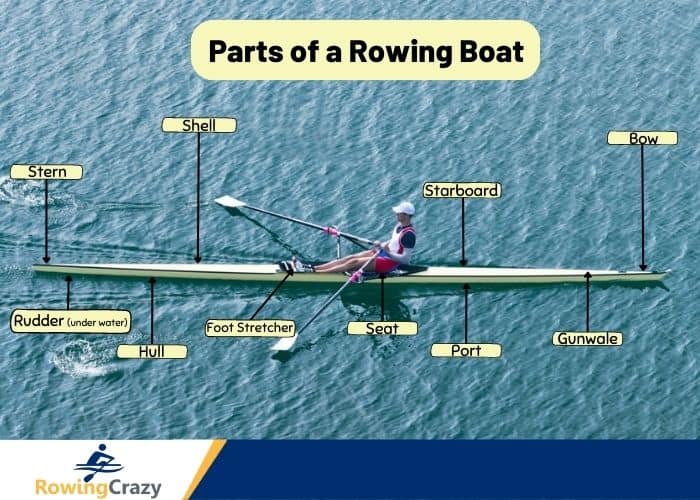
Let’s start with the boat and all the parts involved.
-
- Shell– The boat itself. You may hear it called racing shell or just plain shell.
- Bow– This is the forward section of the boat, and in rowing, this is the part that will cross the finish line first.
- Stern– This is the rear of the boat and the direction that all rowers are facing.
- Starboard– The right side of the boat when moving forward
- Port– The left side of the boat when moving forward
- Hull– The body of the boat
- Seat– Where you put your butt so you can row. Note that the seat slides back and forth,
- Foot Stretcher– Sometimes simply called the stretcher, these are the footrests that are secured to the bottom of the boat. Most rowers already have shoes that are attached to the stretchers.
- Tracks– These are the metal runners on the bottom of the boat that allow the seat to slide back and forth.
- Gunwale– Pronounced gunnel, this is the top edge of the boat.
- Rigger– The arms that are attached to the exterior side of the boat and what oarlocks are attached to.
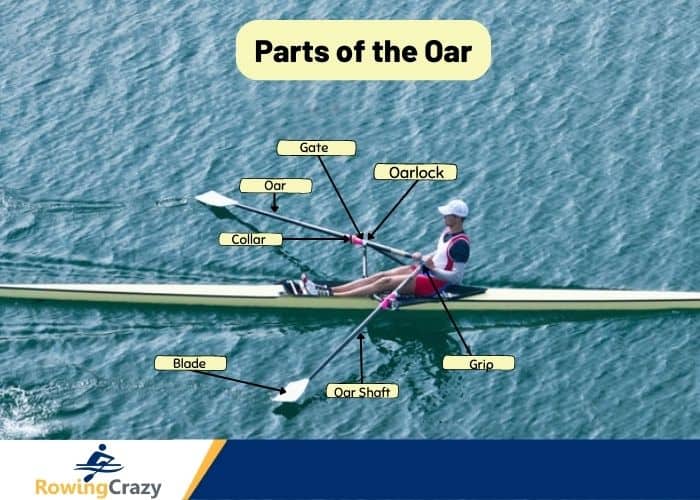
- Oarlocks– This is a device on the end of the rigger that hold the oars in place.
- Gate– The bar across the oarlock that helps keep the oar in place.
- Ribs– Some shell designs have what look like ribs across the bottom of the boat.
- Rudder– The small movable fin on the bottom of the boat that controls the direction. It is controlled by either the coxswain or one of the rowers using a foot pedal.
- Skeg– Often confused for the rudder, this piece looks similar but is fixed in place on the stern. This small piece helps stabilize the boat.
- Oars– Never call the oar a paddle!
- Grip– This is the rubberized portion of the handle that the rower holds.
- Shaft– The long part of the oar between the grip and the blade of the oar.
- Blade– This is the flat part of the oar that goes into the water.
- Collar– Sometimes called a button, the collar is a ring around the sleeve of the oar that adjusts the load.
- Toe– For shells without a coxswain, the rudder is operated by foot using a small pedal called the Toe.
I believe that covers all parts of the shell. Let’s keep going.
The Rowing Stroke
There are four parts to each rowing stroke.
- The Catch position– This is where the blade will first enter the water. The rower is crunched up like a cat, with knees bent, arms forward, and the seat as far forward as possible.
- The Drive– As the name implies, this is where the power happens. The rower will push back with their legs, driving the legs into the stretchers. The rower will then straighten the back, lean backward, and pull the oars at the end of the stroke.
- The Finish– The blade now comes out of the water, and the rower returns to an upright position.
- The Recovery– The rower now swings their torso forward, the oars are out of the water, and they slide the seat back to the start, or the Catch, position.
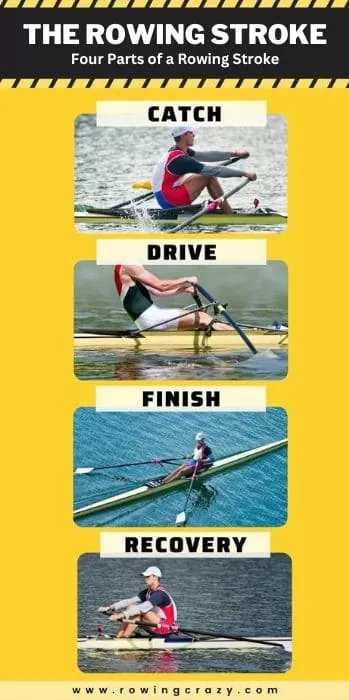
Two other terms to note:
- Feather or Feathered positions- I’ve heard the term feathering as well. This is what the rower does at the end of the Finish. The blade comes out of the water and is turned a bit so that the blade is now parallel to the water, preventing the blade from striking the water again.
- Release- This is the downward motion of the hand on the grip so that the oar is removed from the water. As you reach the Finish, you release the oar, feather the oar, and move on to the Recovery position.
I hope I’ve worded this in a way that makes sense. Let’s talk about the two types of rowing and seat positions.
Rowing Types and Seat Positions
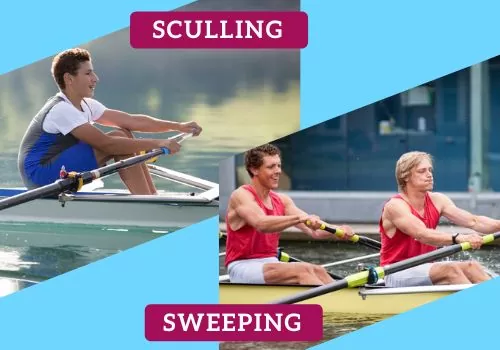
While most people simply call everything in this sport “rowing”, the truth is that there are two different types of rowing.
- Sculling or Sculls – Sculling involves one or more persons in a shell with each person holding two oars, one in each hand. You can have a single scull, which means just one person with two oars, or you can have multiple people in a sculling boat.
- Sweep Rowing – While you will probably hear the word scull or sculling frequently, you won’t hear sweep or sweep rowing nearly as often. This type of rowing is called exactly that, rowing, but on occasion, someone will clarify that they do sweep rowing.
Sweep rowing means that each rower will hold a single oar handle in both hands. This means that in order for the shell to not turn in circles, there needs to be an even number of rowers in the boat. For example, two people rowing on the left side and two on the right side.
You can have a single scull since that person is holding two oars, but you must have a minimum of two people in a sweep rowing shell .
Rowing Positions and Names
Each seat on the boat is numbered from the bow (seat 1) to the stern.
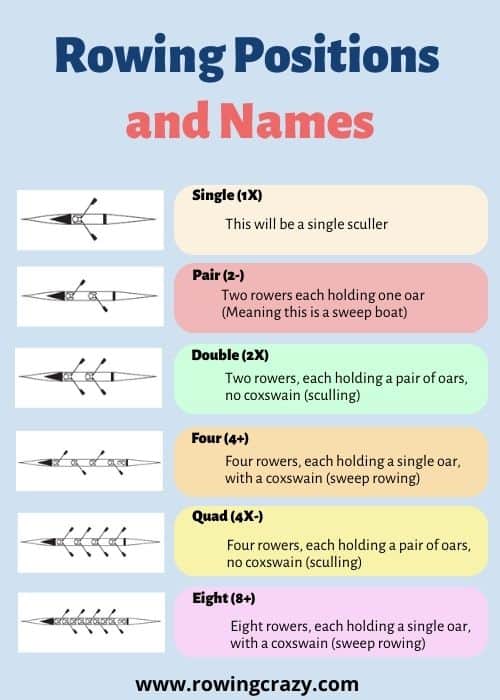
You can tell whether it’s sculling or sweep rowing (read more on rowing vs sculling ) and the number of rowers by the way the boat is named-
- Single (1X)- This will be a single sculler
- Pair (2-)- Two rowers each holding one oar (Meaning this is a sweep boat)
- Double (2X)- Two rowers, each holding a pair of oars, no coxswain (sculling)
- Four (4+)- Four rowers, each holding a single oar, with a coxswain (sweep rowing)
- Quad (4X-)- Four rowers, each holding a pair of oars, no coxswain (sculling)
- Eight (8+)- Eight rowers, each holding a single oar, with a coxswain (sweep rowing)
One more word to know:
Coxswain- The coxswain, often called the cox, is the one person who doesn’t row. The coxswain has many jobs, including steering the boat, deciding when to make strategic moves, and encouraging or coaching the crew. They can be male or female, but the coxswain must be the smallest and lightest member of the crew since they don’t row and add dead weight to the boat.
Boat Positions
Unless you are a single scull, you have a position on the boat, responsibilities, and a name.
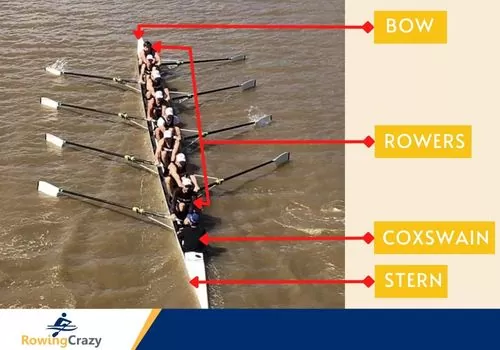
Boat positions include:
- The Stroke– This is the position closest to the stern and the coxswain if there is one. The stroke rower is often the most competitive member of the crew, and they relay information from the coxswain to other team members. The stroke is responsible for setting the stroke per minute rate, which other crew members will follow.
- Stern Pair– In an 8 +, the number 7 rower and number 8 (the stroke) are sometimes referred to as the stern pair. Number 7 will also relay information to those behind them, matching the SPM set by the stroke so others can follow suit.
- The Middle Crew– This bunch has lots of nicknames, including the Meat Wagon, Powerhouse, or The Engine Room. These are the worker bees, if you will, giving the shell the power it needs to win. The heaviest rowers and the most steadfast rowers will be sitting in seats 3-6.
- The Bow Pair– Rowers in seats 1 and 2, sometimes called the bow seat and the #2 seat, are called the bow pair. They are responsible for the overall stability of the shell. These rowers need to react quickly and are often the most technical rowers on the boat.
It’s the coxswain who usually decides who sits where. Everyone has their favorite position, but one of the jobs of coxswains is to know each rower so well that they know where this person will do best.
Rowing Classifications
In the Olympics and national championships, rowing has a set number of qualifications that a crew must meet in order to be allowed in the race.
This is designed to help make the race more evenly balanced. A crew of 4 female scullers over 50 wouldn’t stand a chance against an 8 sweep boat with 8 college-aged, highly trained young men.
Some of the most basic classifications are:
| Rowing Classifications | |
| Lightweight | To qualify for this class, females can weigh no more than 130 pounds and males no more than 150 pounds |
| Heavyweight | If you weigh more than the numbers above, you are considered to be a heavyweight. |
| Juniors | These are individuals who are 18 and younger. In the Olympics, there is no age limit set for the “youngest” only that you be 18 or younger. |
| Novice | Someone who is racing for the first time (outside of school) |
| Open | Here is where you can compete against anyone you like, regardless of age or weight. |
| Masters | This classification is for those who are 27 years old or older. Further breakdowns occur within each decade (30-35 or 50-55 for example) |
High school rowing and college have different classifications as do many regattas. You’ll need to read the classification rules for each regatta you want to race in to see if you qualify.
For example, you may qualify for the lightweight category in one regatta but considered a heavyweight in another race.
While most classifications are within a few pounds, it can make all the difference. Be sure to read the classification rules carefully. Nothing is more frustrating than to weigh in on the day of the race only to find that you or someone in your crew doesn’t qualify!
Additional Terms
As if the above were not enough, there are more terms and lingo that you should familiarize yourself with.
You don’t have to remember everything, but keep these terms in mind:
- All-In-One- This is the one-piece suit, usually made from lycra, that most rowers wear.
- Backing– Sometimes simply called back or river turn, backing means turning the boat around. One side of the boat will row, while the other side sits with their oars out of the water until the boat is facing in the opposite direction.
- Bow Ball– This is a small rubber ball attached to the bow. This is not only a safety device to prevent bumps, but it can be used to determine a winner should two shells be that close to the finish line.
- Bow Number– A small card attached by race official to the bow telling the crew which lane their boat can race in.
- Buoy– A small floating device to mark lanes or hazards in the water.
- Catch a Crab or Crabbing– This is something that happens to even the most experienced rower now and again but something that no one wants to happen. When a rower loses control of their oar, it can hit the water in such a way that it literally tosses the rower out of the boat. Sometimes the grip can hit the rower in the head or in the chest. It’s not fun, but be prepared because it happens to everyone.
- Check It Down!- When you hear the coxswain yell this, all oars are placed vertically in the water so the shell can slow down.
- Cox Box– Some coxswain use an electronic setup with speakers and a microphone so that they can be heard by everyone aboard. There is also a small electronic device that tells the coxswain the stroke rate, the stroke count, the elapsed time, etc.
- Crew– In college, this is the word for rowing. In all other situations, crew refers to the people in the boat who are rowing.
- The Erg- This is an indoor rowing machine that is used for training purposes, especially during the off-season. Erg is short for ergometer.
- Final A– This is the finale that will see awards given at the end of the race.
- FISA– an acronym for the Federation Internationale des Societes d’Aviron. The International governing body for the sport of rowing, like FIFA is for soccer.
- Half-Pressure– As the name implies, rowers are rowing at only half of their capacity.
- Head Race– A different type of race than a regatta. Headraces have rowers racing against a clock over a set distance, which is usually longer than a regatta race. A typical headrace is three miles long.
- Keel– This is the centerline that runs down the middle of the boat. Even if you can’t see it, it’s there!
- A Launch– This is a small motorboat used by racing officials to monitor the boats that are racing.
- Length– Similar to horse racing, the length is the amount that a crew is ahead or behind another boat. For example, you might be 1/2 a length ahead, meaning that you are winning the race by half the length of a boat.
- Let Her Run– Sometimes you’ll hear “Let IT run”. This means that rowers pull their oars out of the water and just let the shell glide along.
- Para-rowing– Sometimes called Adaptive rowing, these races are for those who have a physical or mental handicap. You can read more about para-rowing here.
- A Piece– This refers to any sort of training, such as a 500-meter piece or using the erg to warm up for a 10-minute piece.
- Pogie– The gloves rowers wear that have cutouts for fingertips.
- Power 10– This is a command from the coxswain telling the crew to give it all they’ve got for the next 10 strokes.
- Rating– The number of strokes per minute. For example, an 18 rating means that the rowers were doing 18 strokes per minute.
- Repechage– A second chance for those who failed to qualify for a race.
- Rig– A term used to describe how the boat is designed or set up. For example, it’s a sculling rig.
- Run– This is the distance that a boat moves during one stroke.
- Rushing the Slide– An error made when the rower slides forward too quickly.
- Seat Race– Coaches use this to determine a rowers skills. Each rower sits on one side in separate boats and these two boats do a short race. The rowers then switch sides and race again. This enables coaches or coxswain to determine if someone is a stronger rower on the port or starboard side, etc.
- Set– The balance or the stability of the boat.
- Settle– The part of the race where the rowers settle down into a steady SPM rate.
- Skying– This is another error where the rower puts their hands too low during the recovery, taking longer to put the oars back in the water on the Catch. Every second counts, so yes, this matters!
- Sling– Portable folding boat holders. Two are required for each shell. You don’t want to put your expensive shell on the ground, so it is set on a sling. You’ll see these everywhere at regattas.
- Swamped– When rough waters end up filling the rowboat, and the race (and boat) must be abandoned.
- Swing– When the rowers are in perfect harmony, and the shell seems to move with very little effort. Everyone wants to be in the swing!
- Wash– The wave a shell creates. Not to be confused with wash out (see below).
- Wash Out or Washing Out– An error where the blade comes out of the water during the drive. This not only creates waves but also loses power.
- Weigh Enough– This is a command to stop rowing, or if one is carrying a boat to the water, to stop walking and set the boat down.
- Understroke– This is when the crew is rowing at a lower but more efficient stroke rate than their opponent.
You might hear some other local terms, but this should cover the most common terminology that you will encounter.
Funny Rowing Terms
While some people find some terms hysterical ( I remember being amused by the term catching a crab as a child), but there are plenty of jokes and funny things that you can learn (check out our Rowing Memes )to help you look like a seasoned veteran of the seas!
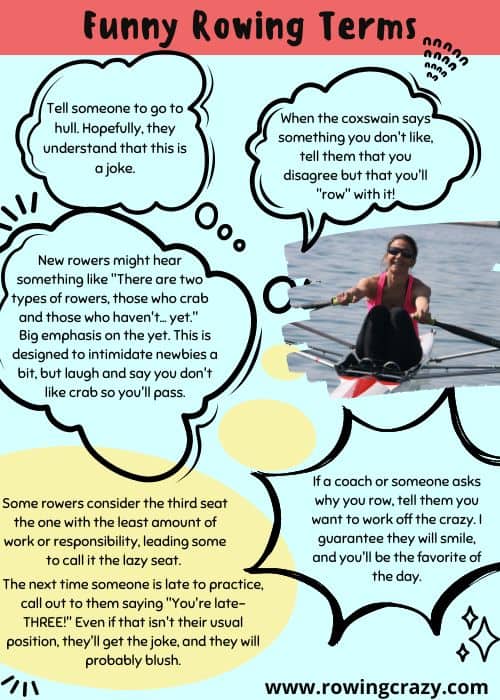
- Tell someone to go to hull. Hopefully, they understand that this is a joke.
- When the coxswain says something you don’t like, tell them that you disagree but that you’ll “row” with it!
- New rowers might hear something like “There are two types of rowers, those who crab and those who haven’t… yet.” Big emphasis on the yet. This is designed to intimidate newbies a bit, but laugh and say you don’t like crab so you’ll pass.
- If a coach or someone asks why you row, tell them you want to work off the crazy. I guarantee they will smile, and you’ll be the favorite of the day.
- Some rowers consider the third seat the one with the least amount of work or responsibility, leading some to call it the lazy seat. The next time someone is late to practice, call out to them saying “You’re late- THREE!” Even if that isn’t their usual position, they’ll get the joke, and they will probably blush.
There are lots of crass jokes that I won’t post here, but you’re sure to find your own funny terms as you attend different regattas.
Ready to Regatta?
Whether you plan to attend a regatta or head race, use a sweep boat or go sculling, I’m betting that you will feel a lot more confident now that you’ve got some of the lingo mastered.
Don’t forget to take along your sense of humor. Rowing is fun, but it’s not easy, and on a bad day, you’ll be a better rowing partner if you can laugh at yourself and the circumstances you find yourself in.
Trust me, no one wants to go to a regatta with a Karen or Brad, so chin up and focus on the fun.
Stay fit and have fun! Enjoy rowing!
Written by Petra Amara – RowingCrazy.com
CEO & Founder of RowingCrazy, National Rower, Coxswain Womens Eight Team, Rowing Coach & Writer
Petra is a Mother of two and owner of Rowingcrazy.com. Petra lives and breathes rowing, she also has a passion for writing which lead her to start RowingCrazy.com to share her rowing experience and expertise with others.



